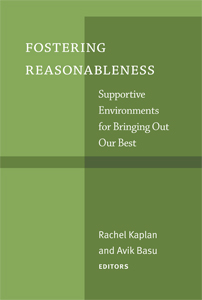
Fostering Reasonableness: Supportive Environments for Bringing Out Our Best
Skip other details (including permanent urls, DOI, citation information): This work is licensed under a Creative Commons Attribution-NonCommercial-NoDerivatives 3.0 License. Please contact mpub-help@umich.edu to use this work in a way not covered by the license.
For more information, read Michigan Publishing's access and usage policy.
Part III. Participation in Environmental Stewardship
Road Map to Part III
The four chapters comprising this section are interesting in their similarities as well as contrasts.
For example, expertise plays important roles in each chapter, yet these roles are quite different. The program described by Nancy Wells and Karl Pillemer relies on experts to guide the process and foster stewardship activities in a structured context. By contrast, Robert Ryan and Jane Buxton’s work examines the roles of community members as they become experts. The process of establishing and sustaining neighborhood greening projects requires interfacing with bureaucratic constraints as well as garnering the support and involvement of the people in the neighborhood. The landowners interviewed by Gordon Bradley and Laura Cooper gain their expertise from the ground up as they learn about their forest landscapes. The guidebook informed by these interviews, however, intends to offer expertise albeit in a way that fosters exploration and model building. Carl Petrich’s chapter reflects on expertise in a variety of ways. Architects and designers often impose their expertise in the structures they create. While users of those structures might become stewards, the experts are less likely to serve in such capacities.
As Petrich shows us, stewardship and attachment have strong connections. Attachment may come from familiarity and aesthetic pleasure gained over time. Stewardship is a key driver in the program that Wells and Pillemer have developed, as it leads community elders to come together and make a tangible difference in their communities. However, whether such a program generates a sense of attachment or leads to further stewarding is not clear. When the land is your own, as in the Bradley and Cooper study, it is not surprising that stewardship and attachment are strong. The Ryan and Buxton example draws on residents’ attachment to their neighborhood, yet many in any neighborhood do not engage in the stewardship activities. However, attachment is likely strengthened not only for the community leaders whose efforts are essential to the greening projects and the community members engaged in sustaining them; as others in these inner-city neighborhoods witness the changes created by the gardens, they too are likely to gain attachment.
A further similarity across the chapters relates to RPM domains. Through structured situations as in the Retirees in Service to the Environment (RISE) program (Wells and Pillemer), presentations and a guidebook (Bradley and Cooper), or trial and error (Ryan and Buxton as well as Bradley and Cooper), model building is a necessary and implicit process in order to achieve stewardship. The experience and familiarity may grow gradually over extended periods (as is true in several of Petrich’s examples) or occur more quickly (Wells and Pillemer), leading to different expressions of attachment and meaningful action.
Chapter 10: Nancy M. Wells and Karl Pillemer, “Environmental Engagement in Later Life: The Reasonable Person Model as a Framework for Intervention”
Nancy M. Wells and Karl Pillemer discuss the RISE program they have been developing to meet the dual needs of increasing capacity in community-level environmental engagement and the desire of many seniors to channel their time and talent toward making a difference. The chapter focuses on ways the RISE program incorporates elements of RPM as well as on assessments of the program’s outcomes in terms of these considerations.
Chapter 11: Robert L. Ryan and Jane Buxton, “Applying the Reasonable Person Model to Urban Greening Projects: Insights from the Inner City”
Green spaces in urban areas have numerous potential benefits that range across the domains of RPM. They increase effectiveness by restoring depleted attentional resources and provide opportunities for citizens to make a difference in their communities through greening projects. Communication between community leaders and participants relies heavily on shared mental models. Ryan and Buxton describe two studies of urban greening projects that suggest that both the urban green spaces and the processes that develop them can be thought of as supportive environments. Not all projects succeed, however, and RPM provides some clues as to why some environments are more supportive than others.
Chapter 12: Gordon Bradley and Laura Cooper, “Planning for Small Forest Landscapes: Facilitating the Connection between People and Nature”
Gordon Bradley and Laura Cooper’s chapter uses the RPM framework to understand the practices of small forest owners in the Pacific Northwest. Bradley and Cooper describe how forest owners develop mental models of their properties through exploration and small experiments. They also describe the restorative impacts that the properties have on their owners as well as the attachment fostered through ownership. The authors intend to use the insights from this work to design a handbook of processes to help forest owners extend their mental models of their land, promote engagement with it, and improve its management.
Chapter 13: Carl H. Petrich, “Fostering Sustainability through the Reasonable Person Model’s Role in Enhancing Attachment”
Carl Petrich’s chapter identifies attachment as a key characteristic of supportive environments. Developing such attachment is a form of building mental models about place. He discusses how places that foster attachment are more likely to meet human needs for aesthetics and functionality—and vice versa. In particular, people find themselves attached to environments that adapt to our needs over time. In such places, people are more likely to interact with and improve the places, whether through modifications or preservation. Thus, attachment serves as a driver for meaningful action.


